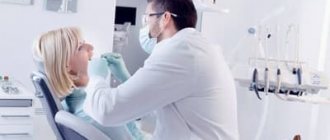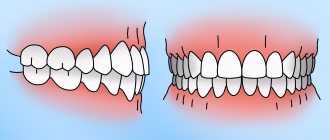Sanitation of the oral cavity is a rather important event, which, unfortunately, is underestimated by many. Although this procedure helps to promptly identify problems with teeth and gums and effectively eliminate them in the early stages. Sanitation can be planned (preventive), or prescribed in connection with other events. A certificate of oral hygiene may be needed in many situations. For example, it is necessary for pregnant women or people who are preparing for surgery.
What is oral sanitation and what procedures does it consist of?
Sanitation of the oral cavity is a set of measures aimed at treating diseases of this area (teeth, gums, tongue, mucous membranes) or preventing their occurrence, as well as eliminating various pathologies (congenital or acquired).
The complex of these measures includes the following procedures:
- treatment of caries (including complicated ones that have progressed to pulpitis or periodontitis). This is the most frequent therapeutic intervention, since almost 90% of the population suffers from dental caries, and also because it is with minor destruction of the enamel that large and intractable problems begin - diseases of the dental roots, infectious lesions of hard and soft tissues, destructive lesions leading to loss of functional units,
- treatment of periodontitis. This is a disease that affects various structures around the tooth root. The danger is that during inflammation, the infection can spread not only to neighboring teeth, but also to the bone, and even to other organs of the head - eyes, ears, sinuses,
- treatment of tooth enamel destruction (including hypoplasia). The enamel covering the crown performs a protective function, so any violation of its integrity threatens damage to softer and unprotected tissues. Depending on the diagnosis and the degree of development of the pathology, the doctor builds a treatment strategy - from the use of remineralizing pastes to installing crowns on the affected teeth.
- treatment of inflammatory processes of soft tissues of the oral cavity. These can be diseases of the gums, tongue, oral mucosa, palate and larynx. Therapy tactics are built depending on the diagnosis and individual factors of the patient’s condition (heredity, pregnancy, the presence of other diseases that provoke inflammation in the oral cavity, bad habits, etc.),
- elimination of tooth deformation (both congenital and acquired) and filling defects. Depending on the clinical picture, defects are corrected using fillings or prosthetics,
- cleaning and curettage of gum pockets. Gum pockets are called the separation of the edge of the gum from the wall of the tooth. In such depressions, as a rule, plaque accumulates, which then hardens, turning into tartar. All sorts of pathogenic microbes love to live there. Removing these deposits prevents the spread of infection and the development of many diseases,
- removal of teeth that have completely lost their functionality. The doctor resorts to this method when restoring the unit is no longer possible for some reason,
- correction of bite. This stage is very important for maintaining dental health, since malocclusion causes inconvenience not only in aesthetic terms. With various defects in the dentition, digestion and speech are affected, the process of salivation is disrupted, and there is a risk of developing caries or other infectious diseases,
- prosthetics. Replacing missing teeth is needed not only to restore the aesthetics of a smile. A complete set of teeth allows you to chew food better, improve diction, maintain the strength of the jaw bone,
- professional teeth cleaning. This set of preventive procedures includes not only the removal of plaque and tartar, but also the treatment of crowns with special restorative and protective preparations, bleaching, fluoridation, silvering (mainly for children) and other hygienic procedures.
Pros and cons of general anesthesia
The main advantage of general anesthesia is absolute comfort and minimal stress for a person; he will not get tired of keeping his mouth open for a long time, which is especially important when treating children. The dentist, in turn, is not distracted by the patient’s reactions and performs the operation without interference.
The disadvantages include:
- Side effects after anesthesia: dizziness, loss of attention, weakness, increased blood pressure, increased heart rate, breathing problems, convulsions, nausea or vomiting, short-term memory problems.
- You should not eat 6 hours or drink 2 hours before surgery.
- It is undesirable to remain in medicated sleep for more than 1.5 hours, and for complex tooth extractions this time may not be enough.
- Having a breathing tube may interfere with oral surgery
- High cost and costs for additional research.
- General anesthesia has a more negative effect on the body than local anesthesia.
- Inability to remove a tooth on the day of treatment due to mandatory preparation for general anesthesia.
- After surgery, you need more time to recover
Indications for sanitation
- upcoming surgical treatment (even with minor interventions, such as abortion, replacement of the eye lens, removal of adenoids, etc.). This is done in order to avoid complications after surgery, because an infection from the oral cavity can enter the blood,
- entering kindergarten or school. Upon admission to an educational institution, a health card is created for each student, which indicates chronic and other diseases, and also monitors what treatment the child receives,
- before pregnancy. When planning to become a mother, women should take care of their health, since pregnancy is a serious test for the body, and the presence of infectious diseases can become a serious test for the fetus. Therefore, it is important to take preventive measures in advance,
- upcoming orthopedic (prosthetics, implantation) or orthodontic (bite correction) treatment,
- work in hazardous industries (especially those related to the chemical industry). Harsh working conditions weaken the body, so workers in hazardous professions must undergo a medical examination, and if any pathologies are detected, immediately receive medical care.
- a history of serious illness (such as diabetes, tuberculosis, rheumatological systemic diseases, etc.). Such complex diagnoses, as a rule, disrupt the functionality of many body systems, and teeth are most often the first to be affected.
- the presence of chronic or genetically determined oral diseases,
- passing the draft commission (for conscript or contract service),
- upcoming long-term business trip to places with limited medical care (for example, third world countries), expeditions, extreme hikes.
Contraindications
The state of medicated sleep is not entirely harmless, and therefore has a number of contraindications. Even if the dentist has recommended general anesthesia for treatment, additional tests may reveal that it is not possible.
Main contraindications:
- full stomach;
- respiratory tract diseases: pneumonia, nasal congestion, bronchial asthma;
- heart failure and the period after a heart attack;
- alcohol or drug intoxication;
- epilepsy;
- taking hormonal medications;
- some forms of diabetes;
- diseases of the endocrine system;
- allergy to drugs for general anesthesia;
- hypertension;
- pregnancy;
How is sanitation carried out?
This event is usually divided into three types:
- individual (is the initiative of the patient himself),
- periodic (if the patient falls into one of the groups for which undergoing sanitation is a necessity, for example, before surgery or pregnancy),
- planned (when the procedure is included in the occupational safety plan or is a prerequisite for employment).
Types of general anesthesia
Depending on how the anesthetic drugs enter the body, anesthesia is divided into: intravenous, inhalational and endotracheal.
With intravenous anesthesia, all drugs are introduced into the body through a venous catheter. During inhalation and endotracheal administration, drugs enter the respiratory tract in the form of gas. Also, a combination of several types of anesthesia is used.
In dentistry, a type of pain relief is also used, such as sedation, which is not general anesthesia. During sedation, a person is given a dose of calming sedatives and local anesthesia is administered, which puts them into a state of semi-sleep, but the patient is conscious.
The presence of an anesthesiologist is not required in this case. Sedatives completely remove mental stress, thereby providing the best analgesic effect.
Stages of reorganization
Stage 1: diagnostic.
At this stage, the dentist examines the oral cavity and identifies defects that need to be eliminated. In some situations, the doctor may prescribe an additional examination - tests, x-rays or ultrasound diagnostics to identify hidden problems.
Stage 2: therapeutic.
This stage is always individual. Its duration, intensity and cost depend on the identified pathologies and the choice of method for their elimination. If the condition of the oral cavity is neglected, then sanitization begins with the removal of damaged teeth, “stumps” and restoration of the gums. Next, the doctor follows the individual clinical picture,
Stage 3: preventive.
For the purpose of prevention, the doctor necessarily recommends that the patient undergo professional teeth cleaning, during which all deposits are removed, and then he applies strengthening or protective preparations to the enamel, and carries out whitening if necessary. Sometimes this stage precedes treatment and even diagnosis. This is done to make it easier to identify problems, because carious lesions and other foci of infection may be hidden under a layer of plaque. And professional hygiene reduces the risk of re-infection with caries during treatment.
Remember! You can skip the therapeutic stage if you pay due attention to oral hygiene every day, follow your doctor’s recommendations and give up bad habits. Preventing caries allows you to avoid more serious health problems and save money.
Features of the operation
With general anesthesia (narcosis), a person enters a state similar to sleep, in which the entire muscular system relaxes, and some reflexes are inhibited, the nervous system is inhibited and pain is not felt.
The decision to perform a dental operation under anesthesia is made by the dentist, who refers the patient to a number of studies:
- Consultation with an anesthesiologist.
- Cardiogram.
- Blood and urine tests.
Removal or treatment of teeth under general anesthesia occurs in the presence of an anesthesiologist, who monitors the patient’s condition and his sleep.
The depth of sleep depends on the amount of drugs administered and is determined by the anesthesiologist. A person is put into a state of anesthesia for a period of 30 minutes to 2 hours, depending on the volume of the upcoming treatment.
The patient is advised not to eat or drink before surgery; an empty stomach is an important condition for such anesthesia.
After the operation is completed, the anesthesiologist administers drugs to awaken and remove anesthetic substances from the body. The patient may experience dizziness, weakness, and a slight decrease in heart rate for several hours after anesthesia.
Sanitation during pregnancy
Pregnancy is a very important period not only for the woman herself, but also for her fetus, so it is better to prepare for such an event in advance. Sanitation of the mouth at the stage of pregnancy planning is a must, because during gestation all calcium and other active substances will be sent to the development and growth of the small organism. Therefore, mom needs to take care of the health of her teeth in advance.
Sanitation of the oral cavity allows not only to treat caries, but also to strengthen tooth enamel, because it bears the main burden. The acid-base balance of saliva changes, the body as a whole undergoes hormonal and metabolic changes, and with vomit during toxicosis, gastric juice gets onto the enamel, which corrodes the enamel. That is why it is important to strengthen your teeth and get rid of all pathologies that increase the risk of developing serious diseases, such as pulpitis or periodontitis.
Important! If conception occurred unplanned, then the woman also needs to undergo sanitation, but here it is important to consult a doctor. Firstly, because in the first trimester there are restrictions on the use of various medications (and some of the drugs used in dental treatment still enter the body with saliva). Secondly, in many women, toxicosis and the gag reflex intensify, which makes it impossible to carry out manipulations in the mouth.
Tooth extraction procedure under general anesthesia
Typically, dental treatment and tooth extraction are performed using local anesthesia.
There are a number of cases when it does not cope with its task: some people do not feel the analgesic effect, they may be allergic to anesthetics, etc. Anesthesia may be replaced by anesthesia.
Tooth extraction under anesthesia can occur in the following cases:
- In young children, in whom such a procedure can cause hysteria and psychological trauma.
- If a person is so afraid of the upcoming operation that they may lose control of their actions, possibly harming them, or lose consciousness.
- In cases where manipulations in the oral cavity cause a strong gag reflex, which a person cannot restrain on his own.
- When there is a complex tooth extraction, a tooth with an incorrectly located root, several teeth at the same time, if a long operation with incisions in the gums is expected.
- The presence of allergic reactions to most local anesthetics.
- If local anesthesia does not provide sufficient analgesic effect.
- If the patient has mental and neurological diseases, disorders of the central nervous system: mental retardation, neuroses, psychopathic conditions.
- If tooth extraction must be accompanied by constant sanitation of the mouth.
- A patient without significant reasons can choose general anesthesia if he has no contraindications.
Sanitation before implantation
Installation of a dental implant is a complex surgical procedure involving the implantation of a foreign body into the jawbone. If there is some source of infection in the oral cavity (an area of carious lesions, inflammation in soft tissues, ulcers on the mucous membranes or tartar), then with a high probability this infection will penetrate into the open wound. This can lead not only to implant rejection, but also to more serious consequences - inflammation of bone tissue and even sepsis.
Therefore, before proceeding directly to installing the implant, the orthopedist directs the patient to sanitize the oral cavity in order to minimize risks.
Reviews
Marina, 28 years old. I once had teeth removed under general anesthesia, the fact is that in order to install a braces system and correct the bite, I needed to remove four teeth.
The dentist offered me the option of general anesthesia and I agreed. She tolerated everything well and did not experience any unpleasant sensations either during or after the operation. I came off the medications quickly - within an hour, and calmly went home.
Alexander, 56 years old. Since childhood, I have been allergic to all local anesthetics, so I treat caries without pain relief at all. But here’s the thing: my wisdom tooth began to deteriorate and it definitely needed to be pulled out. How surprised I was when the doctor offered me general anesthesia for this, I didn’t know about it before.
Of course, I agreed. I was not found to have an allergy to it. The tooth was removed in 20 minutes, after the procedure I felt “like in a fog” for a couple of hours, but then everything went away.
Nastya, 21 years old. I removed 2 teeth, the lower eights, which grew in a non-standard way - horizontally in the gum. I did it under general anesthesia, because... The doctor sawed the teeth into pieces and took them out. The procedure itself went well, then my gums hurt for a week, I rinsed my mouth and drank Ketanov.
Sanitation in pediatric dentistry
“Putting things in order” in a child’s mouth is an important detail not only in the prevention of caries. Timely sanitation allows you to quickly identify pathologies in the formation of the jaw or bite, correct them and thereby provide the child with healthy and properly functioning teeth.
As a rule, oral cavity sanitation is carried out in kindergartens and schools. Its technology is no different from that of an adult: after an examination, the doctor identifies problem areas, treats caries and carries out professional teeth cleaning. If a child has teeth that cannot be restored, they are removed.
Interesting! According to a sociological study in schools in Moscow and the Moscow region, almost half of parents of children of primary and secondary school age (48%) take their child to the dentist only when a problem arises, and 4.6% do not take their child to the doctor even if a pathology is detected. A fifth of respondents (21%) believe that it is enough to bring the child for examination once a year. And only 24% of respondents bring their children for preventive care twice a year.
Is it painful to have professional cleaning?
Patients often wonder if it hurts to have their teeth cleaned at the dentist. Regardless of the method used, there is no pain. A feeling of discomfort may occur when removing mineralized formations. In this case, ultrasound is prescribed. Ultrasonic teeth cleaning is also recommended during pregnancy and increased tooth sensitivity.
Techniques for washing tonsil lacunae
Rinsing the lacunae of the palatine tonsils is a simple procedure, but it should only be performed by an otolaryngologist. Experts do not recommend doing it yourself at home. There is a possibility that the disease will begin to progress and complications will arise. Also, during the manipulation there is a high probability of injuring the tonsils or palate.
The most common methods of rinsing the tonsils are:
- syringe;
- vacuum device "Tonsilor".











